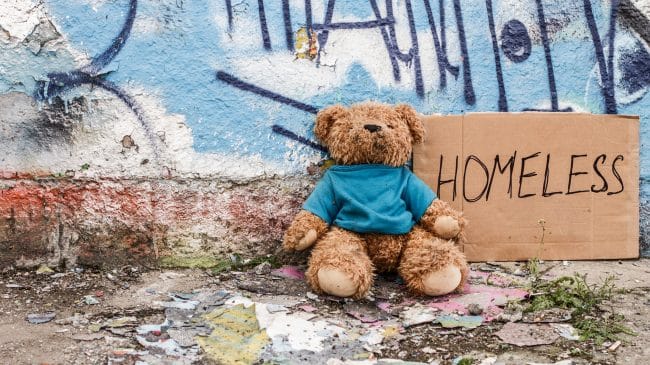Homelessness in America is on the rise for the first time since 2010 due, in part, to a homelessness surge in Los Angeles, Seattle, San Diego and other West Coast cities.
In 2017, the city of Los Angeles and Los Angeles County had the second-highest total homeless population (55,188 total), with almost 75 percent of those people unsheltered. Between 2016 and 2017, individual homelessness grew 9 percent (15,540 people) in major U.S. cities. Los Angeles accounted for 60 percent of the increase.
Homelessness impacts many vulnerable communities in Los Angeles, including veterans. According to the Los Angeles Homeless Services Authority, a total of 4,828 veterans experienced homelessness on a given night in 2017, up 57 percent from the 2016’s figure of 3,071. In February 2018, the Los Angeles Times reported 500 homeless veterans had housing vouchers with nowhere to redeem them.
In May 2018, the Veterans’ Administration (VA) issued a request for information (RFI) seeking private contractors to potentially fulfill the role of Housing Specialist/Landlord Liaison for homeless veterans in the Greater Los Angeles area.
To help find permanent housing for homeless veterans, the U.S. Department of Housing and Urban Development (HUD) and the U.S. Department of Veterans Affairs Supportive Housing (VASH) currently run a combined program (HUD-VASH).
The HUD-VASH program combines Housing Choice Vouchers (HCV), which can be used for privately-owned housing for veterans with VA case management and clinical services to eligible homeless veterans. Since 2008, HUD-VASH has allocated more than 85,000 vouchers to veterans experiencing long-term or repeated homelessness.
However, with increased demand in housing units and decreased housing inventory, landlords across Los Angeles are becoming more cautious with respect to underwriting and leasing evaluations, creating new challenges for the program. Insufficient landlord participation in the HUD-VASH program has resulted in long delays in finding housing for veterans.
To help make the program more effective, HUD-VASH is looking to public-private partnerships (PPPs) for help and the RFI would provide the framework for the private sector to work with HUD-VASH in a combined effort to ending homelessness.
According to the RFI, contractors would work closely with HUD-VASH program staff, providing assistance with marketing, recruitment, relationship development, and tenancy management support of landlords in the community to expand the availability of apartments for veterans accepted into the HUD-VASH program of the Greater Los Angeles Healthcare System.
The objective is to secure long-term relationships with landlords wishing to rent their units to HUD-VASH participants using HVCs. The RFI contractor performance requirements include provisions such as identifying 10 new landlords who are not familiar with the HUD-VASH program and 30 new prospective units for rent, as well as providing education for landlords.
Contractors would also have reporting requirements through monthly written reports and are required to notify the VA of any negative incidents involving a veteran, any pending evictions and to provide any necessary documentation.
The RFI also seeks contractors with a proven track record of experience involving property management for populations served by social assistance programs. The contractors would also be expected to collect performance improvement feedback from landlords and present that information during quarterly staff meetings with HUD-VASH staff. The contractors would also create ways to honor landlords through special events and award ceremonies.
The lengthy requirements for governments wishing to engage in PPPs to ensure private sector accountability in providing a good or service are not uncommon. Combing government and nonprofit resources to achieve a greater good such as ending homelessness has had historical success when executed correctly.
In addition to the Los Angeles-area HUD-VASH program, many other municipalities are using public-private partnerships to address homelessness:
- A Seattle-based nonprofit known as Building Changes has shown promising results by pooling together government, nonprofits and philanthropy to employ an approach to ending homelessness known as ‘diversion’—an early engagement tool that, while not a fit for all homeless cases, works for many and saves money when it does by avoiding more costly approaches.
- Community Shelter Board (CSB), a charity organization in Columbus, Ohio, uses the combined resources of government, nonprofits, and philanthropic organizations to fight homelessness. By managing the funding for local homeless programs and permanent supportive housing, CSB has also demonstrated successful results using PPPs.
- Your Way Home in Montgomery County, PA, is an award-winning program that brings together county government, nonprofits, and other philanthropic groups to work together in a unified, coordinated way to combat homelessness in the county. The success in reducing their homeless populations can also be attributed, in part, to PPPs.
Public-private partnerships are a valuable tool in leveraging collective resources to accomplish the goal of reducing homelessness. The HUD-VASH program’s collaboration with Los Angeles-area landlords provides another example of how PPPs can help solve some of the persistent problems that traditional approaches have left behind.
